ARIS
(workpackage 1 - loria results)
The goal of the ARIS project was to provide new
and innovative AR-technologies for e-(motion)-commerce application,
where the
products can be presented in the context of their future environment.
Two
system approaches have been developed:
1.
An
interactive desktop system, where the end-user can easily integrate 3D
product
models (e.g. furniture) into a set of images of his real environment,
taking
consistent illumination of real and virtual objects into account.
- A mobile AR-unit, where 3D product models can be directly
visualized on a real site and be discussed with remote participants,
taking shared augmented technologies into account. Both systems have
been implemented based on the same technology infrastructure and tested
on well defined application scenarios with end-users.
Our
contribution concerns real-time camera tracking. Several methods have
been
developed in order to obtain fast, accurate and robust tracking over
long
sequences :
markerless
tracking using planar structures
During the first year of the project, we
proposed a real time camera tracking system for scenes which contain
planar
structures. The type of scenes which can be considered with our method
is
large: this is commonly true for indoor environments where the ceiling
or the
ground plane are often visible. This is also often true for urban
outdoor
scenes because the façades of the buildings, the roads and the squares
are
often visible and can be used for registration.
The main idea of the algorithm is to compute
the homographies induced by each visible plane. As the homography is a
function of the camera parameters, the camera pose can be inferred from the set
of homographies induced by the visible planes. This first prototype
allows us
to reach an approximate processing rate of 16 frames per second.
videos
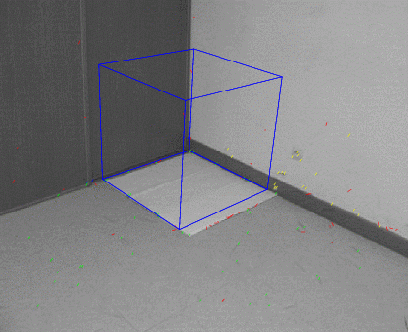 |
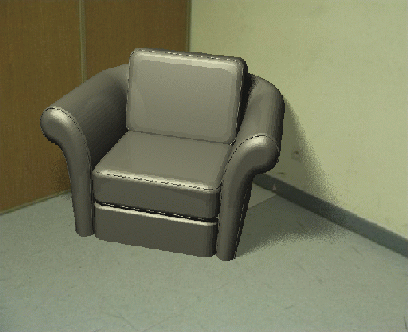 |
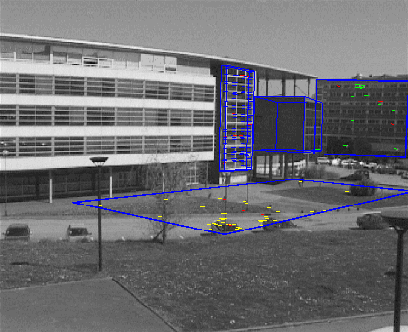 |
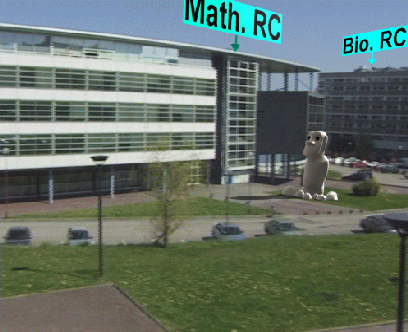 |
| Indoor multiplanar tracking + augmentation |
Outdoor multiplanar tracking
+ augmentation |
||
papers
- Gilles Simon and Marie-Odile Berger. Pose Estimation for Planar Structures. IEEE Computer Graphics and Applications, 22(6):46-53, November 2002. [Abstract] [bibtex-entry]
- Gilles
Simon and Marie-Odile
Berger. Real time registration of known or recovered
multi-planar
structures : application to AR.
In 13th British Machine Vision Conference 2002 - BMVC'2002,
Cardiff, United Kingdom,
pages 567-576,
September 2002.
 [Abstract] [bibtex-entry]
[Abstract] [bibtex-entry] - Gilles
Simon and Marie-Odile
Berger. Reconstructing while registering : a novel approach for
markerless augmented reality.
In International Symposium on Mixed and Augmented Reality -
ISMAR'02, Darmstadt, Germany,
September 2002.
 [Abstract] [bibtex-entry]
[Abstract] [bibtex-entry]
model
selection
Even when the precision of the viewpoints is
improved by considering several planes,
fluctuations in the parameters are often observed and may lead to
unpleasant
visual impressions such as jittering or sliding when augmented scenes
are
considered. These fluctuations are especially conspicuous when the
camera
motion is small because of noise and imprecision in computing the points coordinates. In the past, several
papers used Kalman filtering for prediction and stabilization task.
However,
the use of a Kalman filter is not
always advantageous for AR. This is because a low
order dynamical model of human motion may
not be always appropriate except under
very constraint scenarios.
Following Matsunaga and Kanatani [kanatani00]
and [torr98] we investigate the use of
motion model selection to reduce
fluctuations of the camera parameters and to improve the visual
impression of
the augmented scene. The underlying idea in model selection is as
follows: a
higher order motion model fits any data set more accurately than a
lower order
model. However, high order models fit part of the random noise they are
supposed to remove. Thus, a high order model, although accurate, is
less stable
to random perturbations in the data. A good motion model must strike
the right
balance between accuracy and stability.
The model selection principle demands that the model should
explain the
data very well and at the same time have a simple structure.
Within
the ARIS project, we decide to use together the model selection
strategy
and the multi-planar calibration in order to improve the stability and
the
accuracy of the estimated the
parameters. There are different branches using model selection, but
there is no
such successful criterion in general.
For this reason, we try to compare different model selection and
we especially consider the criteria which
involve the covariance matrix on the estimated parameters and the
Fisher
information matrix. Indeed, often, criteria such as Akaike are only
asymptotic
approximations of a criterion which
includes the covariance or the
information matrix. So, we hope that such criteria will improve the
model
selection.
As expected, the experiments which were
conducted on synthetic images proved that the criteria which involved
the
covariance matrix or the Fisher information matrix gave the best
results. The
experiments using real image sequences taken with a
turntable also proved that the accuracy of the recovered camera
pose is improved by model selection. In
addition, model selection produces smoother trajectory and better
visual
impression. For the closed sequence, Figure
1 exhibits the distance from the
current camera pose to the initial camera pose. The three curves
respectively
plot the actual camera pose, the pose recovered without model selection
and the
pose recovered when model selection is used.
This graphic proves that the use of model selection improves the
accuracy of the viewpoint and reduces noticeably the drift problems
that are
common when long sequences are considered.

Figure 1: comparison of tracking
performance with and without model selection.
Results on a miniature scene and on a real-size indoor
sequence acquired using a hand held camera are shown below. In the
second example, due to the brightness of the
floor, some sheets of paper were put down on it to make easier the
tracking
process. During the sequence, two panoramic motions were realized, one
with a
tripod and the other without
a tripod. Both are correctly
labelled by the
model selection process (The red cross indicates the stationary model,
the
green circle corresponds to the panoramic rotation, and the blue square
to the
general model).
To
conclude, the use of model selection with various criteria proved that
criterion involving information on the covariance of the estimated
parameters
are well suited to camera stabilization. They allow us to produce
smoother
trajectories and better visual impression. In addition,
model selection reduces noticeably the
drift problems that are common when long sequences are considered.
[kanatani00] C. Matsunaga and K. Kanatani}.
Calibration of a Moving Camera Using a Planar Pattern: Optimal
Computation, Reliability
Evaluation and Stabilization by Model Selection. In Proceedings of
6th
European Conference on Computer Vision, Trinity College Dublin
(Ireland),
pages 595—609, 2000.
[torr98] P.H.S. Torr, A.W. Fitzgibbon and A.
Zisserman. Maintaining Multiple Motion Model Hypotheses over Many Views
to
Recover Matching and Structure. In Proceedings of 6th International
Conference on Computer Vision, Bombay (India), pages 485—491, 1998.
videos
 |
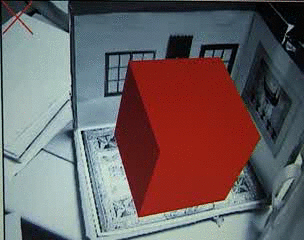 |
 |
 |
| Without
model selection |
With
model selection |
A real-size indoor sequence |
|
papers
- Javier-Flavio Vigueras-Gomez, Marie-Odile
Berger, and Gilles
Simon. Iterative Multi-Planar Camera Calibration : Improving
stability
using Model Selection.
In Eurographics Association, editor, Vision, Video and Graphics
(VVG)'03, Bath, UK,
July 2003.
 [Abstract] [bibtex-entry]
[Abstract] [bibtex-entry]
hybrid
tracking
As pure vision-based tracking methods cannot
usually keep up with fast or abrupt user movements, a hybrid approach
which
combines the accuracy of vision-based methods and the
robustness of
inertial tracking systems has been studied during the last year.
Some
systems have been proposed in the past that combine vision and sensors.
In
[you01], an extended Kalman filter combines landmark tracking and
inertial
navigation. However, extended Kalman filters require good measurement
models
which are difficult to obtain in AR where the user is generally free of
his
motions. More often, sensors are used
as prediction devices to help image feature detection:
in [state96], a magnetic sensor is used to
help landmark search, whereas in [klein02] an inertial sensor is used for detecting edges corresponding to
a wire-frame model of the scene.
Our
approach is close to these works, as we
also use an inertial sensor to improve the matching stage. However, we
brought
significant improvements to these works:
- the inertial device is not used systematically, but only when needed (generally after a large rotation occurred),
-
expected sensor errors
are taken into account at each
step of the algorithm. Propagation of these errors enables us to obtain
refined
research regions of the image features
that
are much more relevant than arbitrary rectangles;
-
sensor data are not only
used to predict the position
of the features, but also to refine the matching process and obtain a
higher
number of correct matches,
-
the
synchronization problem is treated, whereas rarely
mentioned in previous works: we show
that the synchronization delay between image and sensor acquisitions
varies
over time, which requires to perform real-time re-synchronizations
during the
tracking process. We propose a reliable
method for this purpose;
Our
marker-less tracking system is used as a basis of the
hybrid algorithm. The
inertial sensor robustness allows us to
maintain tracking during long sequences. However, the process is incremental and may progressively diverge
because of successive approximations, or even stop when matching fails.
For that
reason, we finally proposed to add markers into the scene, whose
positions are
known. These markers are used to initialize or re-initialize the
tracking
process in case of matching failure or
divergence. Once the initial viewpoint is known, the hybrid system is
used for
tracking and the markers are not used anymore (they can disappear from
the user
field of view). As a result we get a system that is really robust
against fast
camera motions, but also very accurate (no jittering effect) as the
whole
texture information contained on the planar surfaces is used for
tracking.
Moreover, the user is free of his motions. It has been tested on real
and
miniature scenes and it runs at 10 fps on a 1.7 Ghz laptop.
Our
implementation is based on an inertial sensor provided by XSens (model
MT9). We
accurately measured the sensor errors using a motorized pan/tilt unit.
These
errors are handled in the tracking process. In addition, we provided a
tool to perform the sensor/camera device
calibration: indeed, to estimate camera rotations from sensor
rotations, it is
necessary to know the rigid transformation between these two devices. Our tool is based on automatic detection of
a calibration target for several positions of the sensor / camera
device, and a
classical hand-eye calibration is performed [tsai89].
[klein02] G.
Klein and T. Drummond. Tightly Integrated Sensor Fusion for Robust
Vision
Tracking. In Proceedings of the
British Machine Vision Conference, BMVC 02, Cardiff, pages 787—796,
2002.
[state96] A. State, G. Hirota, D. Chen, W.
Garett and M. Livingston. Superior Augmented Reality Registration by
Integrating Landmark Tracking and Magnetic Tracking. In Computer
Graphics
(Proceedings Siggraph New Orleans), pages 429—438, 1996.
[tsai89] R. Y. Tsai and R. K. Lenz.A New technique
for Fully Autonomous and Efficient 3D Robotics Hand/Eye Calibration. In
IEEE
Transactions on Robotics and Automation 5(3):345—358, June 1989.
[you01] S.
You and U. Neumann. Fusion of vision
and gyro tracking for robust augmented reality registration. In Proc.
IEEE
Conference on Virtual Reality, pages 71—78, March 2001.
videos
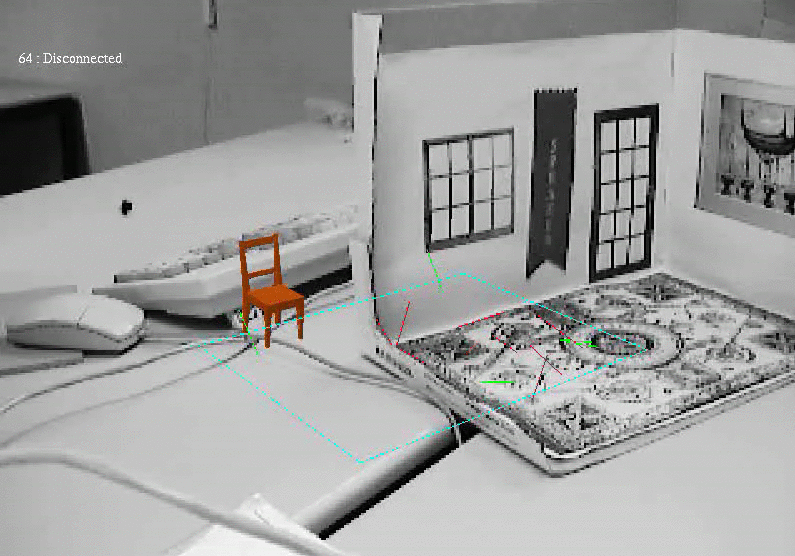 |
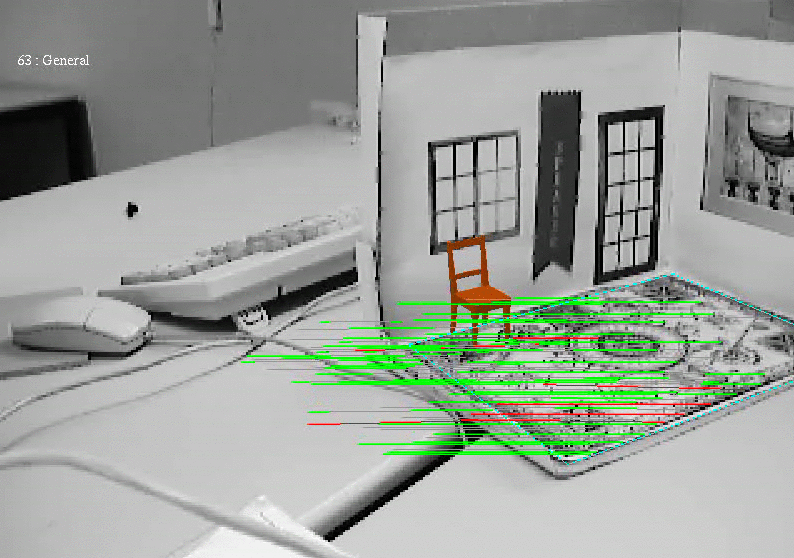 |
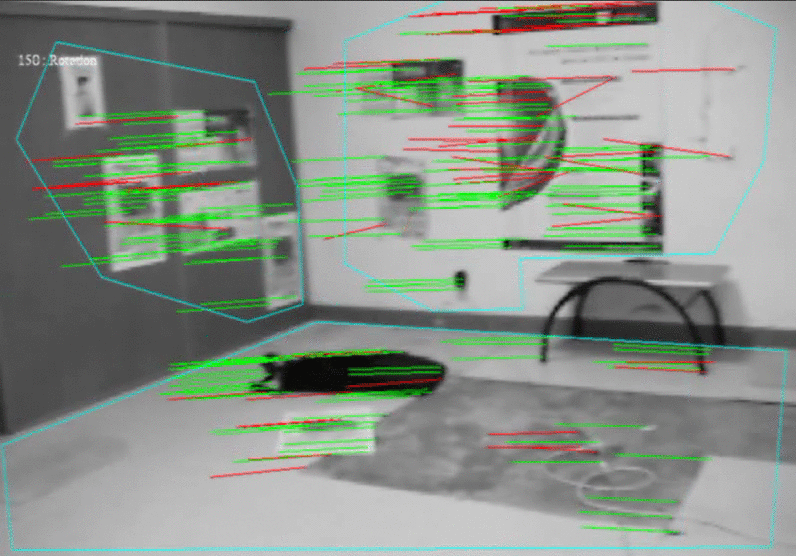 |
 |
| Purely
vision-based tracking with an abrupt motion |
Same
sequence using sensor prediction |
A real-size sequence |
|
 |
Presentation of the
complete mobile ARIS system |
 |
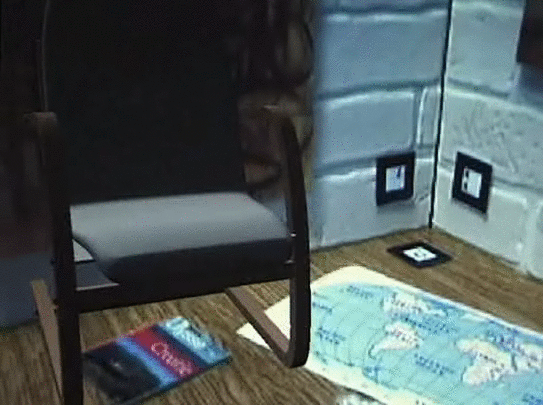 |
|
| Ismar'04 demo : scene reconstruction, hybrid tracking and (to compare) tracking using markers only | ||
papers
- Michael Aron, Gilles Simon and Marie-Odile Berger. Handling uncertain sensor data in vision-based camera tracking. In International Symposium on Mixed and Augmented Reality - ISMAR'04, Arlington, VA, November 2004.